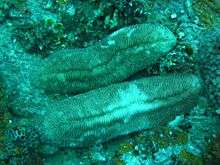Herpolitha
| Herpolitha limax | |
|---|---|
 | |
| Scientific classification | |
| Kingdom: | Animalia |
| Phylum: | Cnidaria |
| Class: | Anthozoa |
| Order: | Scleractinia |
| Family: | Fungiidae |
| Genus: | Herpolitha Eschscholtz, 1825 [2] |
| Species: | H. limax |
| Binomial name | |
| Herpolitha limax (Esper, 1797) [3] | |
| Synonyms[3] | |
| |
Herpolitha is a monotypic genus of mushroom corals in the family Fungiidae. The only member of the genus is Herpolitha limax, commonly known as the tongue, slipper, mole or striate boomerang coral. It is a free-living species and is native to reefs and lagoons in the Indo-Pacific region. The International Union for Conservation of Nature has assessed this coral as being of "least concern".
Description
Herpolitha limax has an elongated structure with somewhat rounded ends and a single, central, axial furrow that extends nearly from end to end. In the furrow are many conspicuous slit-like mouths and there are irregularly spaced, less-distinct mouths elsewhere. The primary septa are densely-toothed with fine spines and do not reach the edge of the colony. The costae are low with crowded, obtuse teeth. Sometimes the furrow is forked and forms a "Y" shape, a "T" shape, or even an "X" shape. This coral can grow to about 45 cm (18 in) long and 10 to 15 cm (4 to 6 in) wide and is usually some shade of grey, brown or greenish-brown.[3][4][5]
Distribution
Herpolitha limax is native to the Indo-Pacific region, its range extending from East Africa and the Red Sea to Australia, Indonesia, Papua New Guinea and the South Central Pacific. It is found on reef slopes and in lagoons, often in close proximity to Fungia spp.[4] at depths down to about 30 metres (98 ft).[1]
Ecology
It is unclear whether Herpolitha limax should be considered a solitary coral with multiple mouths, or whether it is a colonial species, consisting of many individuals, each with its own separate mouth.[6]
Herpolitha limax is a zooxanthellate species of coral, containing symbiotic dinoflagellates within its tissues. Under stressful conditions it is susceptible to bleaching and corals appear white after expelling their symbionts. In a period of high water temperature in Thailand in June 2010, bleaching was common and 52% of the corals of this species were affected, along with many other species of mushroom coral. By the following February, they seemed to have recovered with no trace of thermal-induced bleaching being present, and the species composition being similar to that before the bleaching event.[7]
Status
Herpolitha limax has a very wide range and is a common species in suitable habitats. The population trend is unknown but this coral is harvested for the reef aquarium trade, over 2,000 pieces being collected in 2005. Corals face threats associated with climate change but the International Union for Conservation of Nature has assessed the conservation status of this species as being of "least concern".[1]
References
- 1 2 3 Hoeksema, B.W.; Rogers, A.; Quibilan, M.C. (2014). "Herpolitha limax". IUCN Red List of Threatened Species. Version 2013.2. International Union for Conservation of Nature. Retrieved 2015-05-01.
- ↑ Hoeksema, Bert (2015). "Herpolitha Eschscholtz, 1825". World Register of Marine Species. Retrieved 2015-04-29.
- 1 2 3 Hoeksema, Bert (2015). "Herpolitha limax (Esper, 1797)". World Register of Marine Species. Retrieved 2015-04-29.
- 1 2 "Herpolitha limax". Australian Institute of Marine Science. 2013. Retrieved 2015-04-29.
- ↑ Sprung, Julian (1999). Corals: A quick reference guide. Ricordea Publishing. p. 57. ISBN 1-883693-09-8.
- ↑ Veron, J.E. (2013). "Colony formation". Corals of the World. Australian Institute of Marine Science. Retrieved 2015-04-30.
- ↑ Hoeksema, B.W.; Matthews, J.L.; Yeemin, T. (2012). "The 2010 coral bleaching event and its impact on the mushroom coral fauna of Koh Tao, western Gulf of Thailand" (PDF). Phuket mar. biol. Cent. Res. Bull. 71: 71–81.
